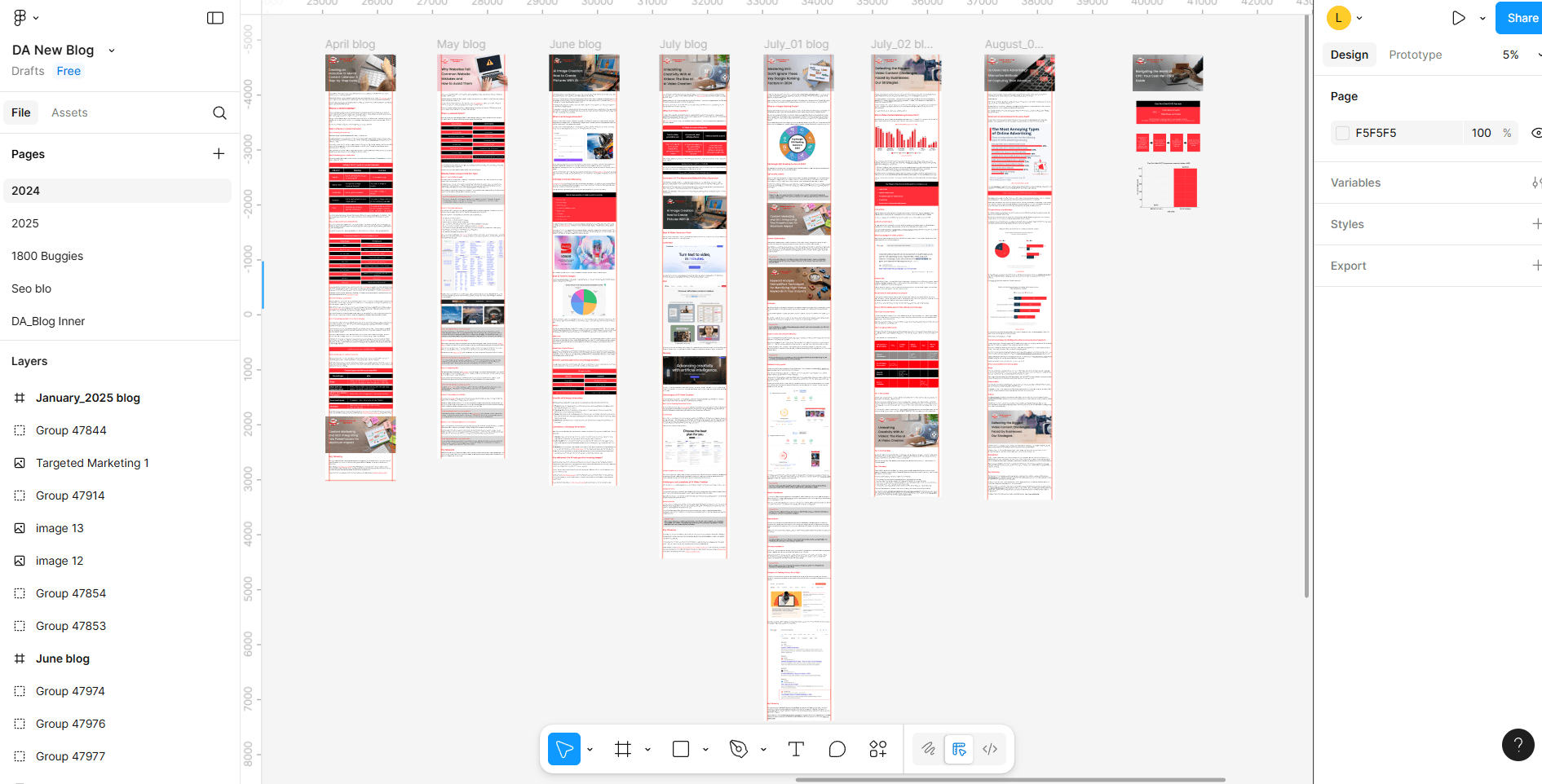- 25th July, 2025
- By Rob Lawson
Unveiling The Future of App Development: Vibe Coding with Bolt & Figma

Technology evolves at a breathtaking pace, fundamentally transforming the way businesses operate, compete, and grow. A recent Deloitte Global Tech Trends report revealed that over 68% of executives are prioritising investments in low-code and AI-powered development platforms to accelerate innovation and reduce time-to-market. In this fast-moving landscape, staying ahead means embracing tools that enable rapid, intelligent digital transformation.
Enter Vibe Coding, a bold new frontier in application development. Designed to streamline and democratise the development process, Vibe Coding allows users to describe desired functionality in natural language, using AI to automatically generate working code. This evolution not only reduces the dependency on traditional coding skills but also empowers cross-functional teams to bring digital products to life faster and more efficiently.
Today, we delve into how forward-thinking platforms like Figma, a collaborative UI/UX design tool, and Bolt, a next-generation AI-driven app builder, are enabling startups and enterprises alike to ideate, design, and deploy applications with unprecedented speed. Whether you're launching your MVP or scaling enterprise-grade solutions, these tools represent a leap forward in how digital experiences are imagined and executed.
What is Vibe Coding?
Vibe Coding represents a paradigm shift in modern application development, redefining how we turn ideas into functional software. The term was coined by a renowned computer scientist with a background in pioneering projects at Tesla and OpenAI, lending credibility and depth to its innovation.
At its core, Vibe Coding leverages natural language interaction with AI as the foundation of the development process. Instead of writing complex code manually, users can communicate directly with AI systems in plain English, describing the features, logic, and functionalities they envision. The AI then intelligently interprets these instructions and generates the corresponding code in real time.
This breakthrough approach democratises software creation, enabling non-technical founders, creatives, and visionaries to bring their digital products to life without needing to master programming languages. By bridging the gap between human intent and machine execution, Vibe Coding empowers a new generation of builders to innovate faster, smarter, and more inclusively.
The Mechanics of Vibe Coding
The core principle of Vibe Coding revolves around removing the communication gap between humans and machines. It enables a more natural, intuitive process of building software, allowing users to focus on ideas rather than syntax.
Here's how it works:
⚡Describe Functionality:
Users start by providing a clear verbal or written description of what each screen or feature in their app is intended to do. This allows them to express their goals in everyday language, without needing technical coding knowledge.
For example, a user might say, "I want a screen that lets users enter their daily water intake and shows a chart of their history." The AI understands this and prepares the necessary components for the app.
⚙ Real-Time Coding:
As descriptions are given, the AI instantly interprets and generates working code, constructing both the visual interfaces and underlying logic in real-time. The experience feels less like programming and more like orchestrating, where the user's imagination takes center stage and the AI translates thought into action with seamless precision.
For instance, after describing the desired feature, the AI could immediately create the required input form, connect it to a database for tracking entries, and generate a chart to visualize the results, all without manual coding.
🔍 Iterative Design:
Users can refine the app through ongoing interaction with the AI. They can revise, expand, or adjust features, imagery and videos at any moment, and the AI quickly updates the code. This creates a smooth, continuous development cycle.
For example, if the user decides later to add a daily reminder function, they simply ask, "Add a reminder that notifies the user at 9 AM every day," and the AI updates the app accordingly.
The Role of Figma in Vibe Coding
In the world of Vibe Coding, Figma isn’t just a design tool; it’s the visual language that sparks creation. It transforms abstract ideas into concrete, collaborative prototypes, acting as both the canvas and the compass for app development. When paired with the real-time intelligence of Vibe Coding, Figma becomes more than a sketchpad; it becomes a launchpad.
Here's how Figma seamlessly integrates into the heart of Vibe Coding:
Every great app begins with a vision, and Figma brings that vision to life with precision and flexibility. Users sketch intuitive wireframes or rich mock-ups, laying out every screen, interaction, and transition. These aren't just drawings, they are functional blueprints, visually mapping how users will experience the app. This process shifts the mental model from code-first to experience-first, ensuring that user flow drives technical architecture not the other way around.
Design is no longer a solitary act. With Figma's real-time collaboration, entire teams, designers, developers, and product managers can co-create and iterate together in one unified space. Feedback is no longer delayed or lost in translation; it's immediate, visual, and actionable. With every comment, tweak, and update happening live, decisions are accelerated and silos disappear. Vibe Coding harnesses this collaborative rhythm, translating those visual decisions into code on the fly.
What makes Figma truly transformative in the Vibe Coding workflow is its extensibility. With smart plugins like Bolt, the lines between design and development blur. UI elements designed in Figma can be instantly interpreted and rendered into working code by the Vibe Coding engine. It's not just exporting, it's syncing the soul of the design directly into the digital fabric of the app. This deep integration turns static designs into living, breathing products without losing fidelity, intent, or time.
Introducing Bolt: The Game Changer

In the fast-evolving landscape of no-code and AI-assisted development, Bolt emerges as a pivotal force, a tool that doesn’t merely support creativity but supercharges it. Built to integrate seamlessly with Figma, Bolt acts as the missing link between static design and dynamic functionality. It empowers creators to transcend the boundaries of traditional design tools by injecting intelligence, logic, and backend capability directly into the visual workspace.
Here’s how Bolt revolutionises the transition from concept to creation:
Bolt plugs directly into Figma, enabling seamless interaction between design and code. It reads user input embedded in the design, recognising not just the visual elements, but the intent behind them, and translates that input into clean, structured, and executable code. This tight coupling eliminates the traditional handoff between designers and developers, accelerating the path from concept to creation.
Users simply point to elements within their Figma designs, like buttons, sliders, or input fields, and describe what they should do. Whether it's triggering a calculation, navigating to a new screen, or displaying live data, Bolt captures the intent and implements it with precision. It empowers creators to move beyond visuals and define behaviors without needing to touch a single line of code.
Bolt doesn't just stop at the front-end. It intelligently generates the full application stack, setting up databases, configuring server logic, and establishing secure APIs. What was once a fragmented workflow, spread across multiple tools and teams, is now unified within a single, fluid process. With Bolt, ideas move from static sketches to fully operational applications faster than ever, reducing development time from weeks to hours without compromising quality or scalability.
Why Vibe Coding Matters for Entrepreneurs
Entrepreneurship thrives on speed, creativity, and bold execution, but all too often, brilliant ideas are held back by a lack of technical resources or programming knowledge. For many early-stage founders, the challenge isn't dreaming big, it's building fast enough to keep up with opportunity. Vibe Coding changes this equation.

Here’s why Vibe Coding is a powerful tool for today’s founders:
- Fast Prototyping: Whether you're validating a business concept, demoing for investors, or building an MVP, rapid prototyping is essential. With Vibe Coding, entrepreneurs can produce interactive, testable application prototypes in a fraction of the time it would take using conventional methods. By simply describing desired functionality, users can watch their application design come to life instantly. It’s rapid iteration without the wait, putting momentum back in the hands of creators.
- Cost Efficiency: Startups operate under tight financial constraints, and technical development is often one of the largest early expenses. Vibe Coding reduces this cost dramatically by cutting out the need for full-scale development teams during the most iterative phases of product creation. With fewer hours spent on manual coding and fewer resources tied up in early-stage builds, founders can stretch their budgets further, redirecting funds toward growth, marketing, or customer acquisition. The result? Greater impact with leaner operations.
- Innovation Facilitation: Vibe Coding liberates entrepreneurs from the technical grind, allowing them to focus on their core strengths: ideation, strategy, and business development. Instead of spending weeks trying to learn code or manage outsourced development, founders can use natural language to guide their product’s evolution in real time. This shift removes the bottlenecks that typically slow down innovation, giving founders the freedom to iterate quickly, respond to market feedback, and shape their product with clarity and control.
In essence, Vibe Coding acts as a co-creator and a digital partner that interprets your ideas and executes them with precision. It enables entrepreneurs to dream bigger, move faster, and build smarter, regardless of their technical background.
A Closer Look: Real World Applications
Consider a startup looking to launch a new application aimed at improving workplace productivity. Using Figma to design the app's interface, the team can quickly visualise user pathways and interactions. With Bolt, these designs are transformed into a working application, demonstrating how data collection, task management, and communication are streamlined. This approach saves time, reduces errors, and promotes innovation, all without traditional coding.
Another example involves a large corporation wanting to deploy a new client-facing app faster. Vibe Coding allows the internal team to handle design and functionality description, using Bolt to take care of coding and deployment tasks, vastly shortening the development cycle.
Key Takeaway
As low-code and no-code technologies become standard across industries, forward-thinking brands are using vibe coding to do more than just build apps; they're accelerating campaigns, improving user journeys, and testing bold digital strategies services with minimal overhead
Is your business ready to stay nimble and consistently deliver exceptional digital experiences? If you're looking to enhance brand visibility through superior app development, connect with an assassin to learn how our Website as a Service (WaaS) solutions can make it happen
Frequently asked questions
1. What is Vibe Coding and how does it work?
Vibe Coding is an AI-driven app development approach that allows users to describe functionality in natural language. The AI interprets these instructions in real-time and generates the necessary code, creating both the interface and logic without requiring manual coding.
2. How do Figma and Bolt support Vibe Coding?
Figma enables collaborative UI/UX design and acts as the visual foundation, while Bolt integrates with Figma to convert those designs into functional code. Together, they allow users to move from visual mockups to fully working applications without traditional development handoffs.
3. Who benefits most from using Vibe Coding?
Entrepreneurs, non-technical founders, and cross-functional teams benefit most, as Vibe Coding enables fast prototyping, reduces development costs, and eliminates the need for deep coding knowledge to build digital products.
4. Can Vibe Coding handle backend functionality as well?
Yes, with the help of Bolt, Vibe Coding generates full-stack applications. It sets up databases, server logic, and APIs, providing a complete end-to-end solution from frontend to backend.
5. What makes Vibe Coding faster than traditional development?
Vibe Coding accelerates development by replacing manual coding with AI interpretation of natural language, allowing real-time updates, seamless integration with design tools like Figma, and instant conversion of design elements into executable code via Bolt.
6. Does Vibe Coding replace the need for developers?
Vibe Coding augments and accelerates development, allowing existing development teams to focus on more complex, strategic tasks. While it empowers non-technical users to build, it often serves to streamline workflows for technical teams rather than completely replacing them.